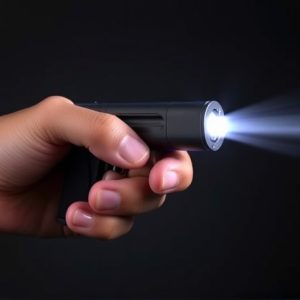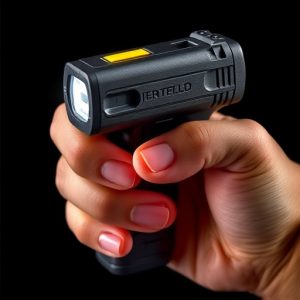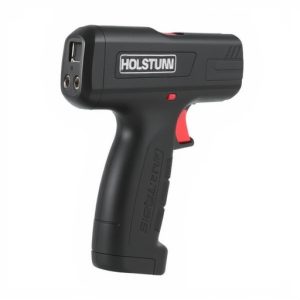Decoding Stun Gun Effectiveness: Insights into Electrical Output Mechanisms
Stun guns are non-lethal defense mechanisms that operate through electro-muscular pulses (EMPs), de…….
Stun guns are non-lethal defense mechanisms that operate through electro-muscular pulses (EMPs), delivering high-voltage, low-current electrical shocks to temporarily incapacitate an attacker. These devices work by causing involuntary muscle contractions and disorientation, effectively neutralizing a threat without fatal outcomes. The effectiveness of stun guns is achieved through a precise balance between voltage and current; they produce voltages ranging from 250,000 to 4,000,000 volts, with the current typically being no more than 2 to 4 milliamperes. This balance ensures that the shocks are strong enough to penetrate clothing and elicit a response but weak enough to avoid harming vital organs or causing severe injury. Users can adjust the intensity of the shock by changing the distance between electrodes, influencing resistance and current flow. Stun guns are designed with safety features such as grip security and power status indicators, making them suitable for self-defense while requiring users to understand their electrical mechanisms to use them effectively and responsibly in a variety of situations. Understanding how a stun gun works is essential for both potential users and policymakers involved in legal considerations regarding these devices.
When encountering the term “stun gun,” curiosity naturally arises about the technology that powers these devices and their role in personal defense. This article delves into the inner workings of stun guns, dissecting how they function and what determines their effectiveness. We’ll explore the mechanics behind stun guns, including the electrical components that drive their capacity to incapacitate, the critical interplay between voltage and current, and the importance of conductive materials and dart configurations in their design. Understanding these aspects is crucial for grasping how a stun gun works.
Furthermore, we’ll examine the impact of stun gun output on their effectiveness, sheddding light on the factors that influence potency. The science behind electroshock and its effects on muscular function will be clarified, as well as the legal and ethical implications that accompany the use of such devices.
Lastly, we’ll investigate advancements in stun gun technology aimed at optimizing safety and performance, highlighting how users can ensure their own security and the longevity of their devices. This includes a look at recent improvements in stun gun electronics and the best practices for effective use. Join us as we unravel the complexities of stun gun electrical output and its significance in the realm of personal defense technology.
Unraveling the Mechanics Behind Stun Guns: How Do They Work?
Stun guns are devices designed to incapacitate an opponent through the delivery of a high-voltage, low-current electrical shock. At the core of their operation lies the electro-muscular pulse (EMP) generator, which converts electrical energy into EMPs that disrupt muscle control, causing temporary paralysis or pain in the target. The mechanics behind stun guns are intricate and involve several components working in concert.
Upon activation, the stun gun’s circuitry completes an electric loop between two or more electrodes. This loop is typically powered by rechargeable batteries. The device emits electrical impulses that range from 50,000 to 100,000 volts, though the actual current delivered is relatively low, often ranging from 2 to 4 milliamperes. This contrast between high voltage and low current ensures that the shock is incapacitating without being lethal. The electrical output is specifically calibrated to penetrate an assailant’s defenses while minimizing damage or injury. The intensity of the shock can be modulated by adjusting the gap between electrodes, which in turn affects the resistance and current flow. This precise control makes stun guns effective self-defense tools, capable of overcoming an attacker without resorting to lethal force. Understanding how a stun gun works is crucial for both users and lawmakers to assess their role in personal safety and legal contexts.
– Electrical Components and Design
Stun guns are non-lethal self-defense tools that utilize high-voltage, low-current electrical charges to incapacitate an attacker. The effectiveness of a stun gun is primarily due to its ability to overload the muscles and nerves, causing involuntary muscle contractions and disorientation. Central to how a stun gun works are its electrical components and design. Typically, these devices consist of a power source, electrodes, and a control switch. The power source, often rechargeable batteries, stores electrical energy. When activated via the control switch, this energy is rapidly delivered through the conductive probes or prongs of the electrodes into the target’s body.
The design of stun guns is carefully engineered to ensure safe and effective use. The electrical output is modulated to produce a high-voltage shock without delivering enough current to penetrate deep into the body, which could cause harm beyond the intent of incapacitation. This delicate balance between voltage and current is critical; high voltage makes the shock painful and disorienting, while controlled current distribution ensures that the electrical impact targets only the muscles and nerves, avoiding vital organs and reducing the risk of severe injury or long-term effects. The design also takes into account the interface with the user, providing a reliable grip and clear indication of power status and activation state to prevent accidental discharge. Understanding the electrical components and design is essential for users to operate stun guns safely and effectively in self-defense situations.
– The Role of Voltage and Current in Stun Gun Capacity
Stun guns are non-lethal self-defense devices that deliver a high-voltage, low-current electrical shock to incapacitate an attacker. The effectiveness of a stun gun is primarily determined by two key factors: voltage and current. Typically, stun guns generate an electrical output ranging from 250,000 to 4,000,000 volts. However, it’s the amperage or current that actually flows through the attacker’s body that is crucial in rendering them immobile. A high-voltage electrical charge initiates neuromuscular dysfunction by disrupting the electrical signals between the brain and the muscles, causing involuntary muscle contractions and rendering the target disoriented or temporarily paralyzed.
Understanding how a stun gun works involves recognizing that its capacity is not solely based on voltage alone. While higher voltages can penetrate thicker clothing and potentially reach the skin, the current must be sufficient enough to impact the nervous system. The current, measured in milliamperes (mA), needs to be strong enough to affect the target’s muscular responses. A stun gun with a lower voltage but higher current can be more effective than one with a high voltage and low current because it delivers a stronger electrical shock. Manufacturers often optimize their designs to ensure a balance between voltage and current, resulting in a stun gun that can deliver an incapacitating shock under various conditions. Users should be aware that environmental factors such as weather and the target’s physiology can influence how a stun gun functions, making it essential to consider these variables when evaluating the device’s effectiveness for self-defense.


